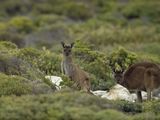Earth's natural resources include air, minerals, plants, soil, water, and wildlife. Conservation is the care and protection of these resources so that they can persist for future generations. It includes maintaining diversity of species, genes, and ecosystems, as well as functions of the environment, such as nutrient cycling. Conservation is similar to preservation, but while both relate to the protection of nature, they strive to accomplish this task in different ways. Conservation seeks the sustainable use of nature by humans, for activities such as hunting, logging, or mining, while preservation means protecting nature from human use. This difference is illustrated by how the United States manages its public lands. The goal of National Parks, for instance, is preservation with an emphasis on causing minimal change to the landscape or environment, meanwhile National Forests can be used for cattle grazing, lumber, hunting, and recreation. Continued human population growth has led to unsustainable rates of consumption of our natural resources, resulting in a loss of Earth's biodiversity. The main factors driving biodiversity loss include habitat destruction, climate change, invasive species, overexploitation, and pollution. Declining biodiversity is closely intertwined with species extinction. While extinction is a normal process of nature, the rate at which it is happening today is not. Scientists estimate that current extinction rates are about a thousand times higher now than would be expected based on the fossil record, and that we may be experiencing a mass extinction event, which is when 75 percent or more species are lost at a time. The extinction of the passenger pigeon is a famous example of an extinction caused by human activity. It was once the most abundant land bird in North America, with a population of approximately three to five billion when Europeans arrived. Despite its vast numbers, this pigeon became extinct in the wild by the 1900s because of overhunting. The last individual bird, named Martha, died in captivity in 1941 at the Cincinnati Zoo. Conservation practices and policies—ranging from the removal of invasive species, to setting aside protected land for wildlife and plants, to establishing the U.S. Endangered Species Act (ESA)—have been put in place to combat these extinction pressures. Currently, more than 26,500 species are estimated to be at risk of extinction, though the exact number is difficult to calculate. One of these species is a small porpoise called the vaquita. With fewer than thirty individuals remaining in the wild, the vaquita is the world's most endangered marine mammal. They only live in the northern part of the Gulf of California and their biggest threat is an illegal fishery for the totoaba fish. The vaquita gets caught and tangled in the nets used to catch the totoaba, which are themselves endangered. Despite conservation efforts, the vaquita will likely go extinct in the next few years with so few numbers and continued threats. Other animals, including the grizzly bear, bald eagle, and California condor, have recovered from near extinction thanks to conservation action under the ESA.

Establishing protected areas not only helps conserve the natural landscape and geography, but also the wildlife that lives there, like these western grey kangaroos (Macropus fuliginosus) in Flinders Chase National Park in South Australia, Australia.
Photograph by Joe Scherschel
Noun
all the different kinds of living organisms within a given area.
Noun
management of a natural resource to prevent exploitation, destruction, or neglect.
Noun
process of complete disappearance of a species from Earth.
marine mammal
Noun
an animal that lives most of its life in the ocean but breathes air and gives birth to live young, such as whales and seals.
mass extinction
Noun
extinction event in which a large number of species go extinct in a relatively short period of time.
Noun
protection from use.
sustainable
Adjective
able to be continued at the same rate for a long period of time.
Posted by: cherrylcherrylgrohe0268899.blogspot.com
Source: https://www.nationalgeographic.org/encyclopedia/conservation/
Post a Comment